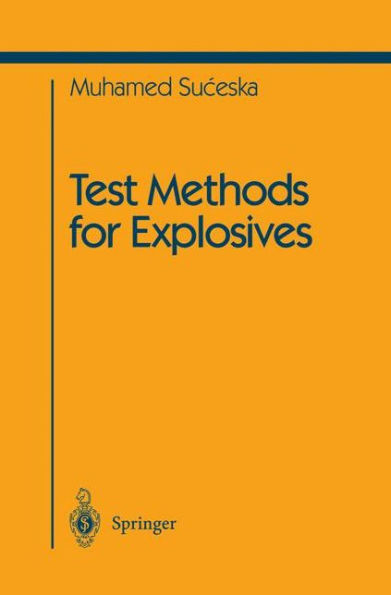5
1
9780387945552


$279.99

Test Methods for Explosives / Edition 1 available in Hardcover

- ISBN-10:
- 0387945555
- ISBN-13:
- 9780387945552
- Pub. Date:
- 10/12/1995
- Publisher:
- Springer New York
- ISBN-10:
- 0387945555
- ISBN-13:
- 9780387945552
- Pub. Date:
- 10/12/1995
- Publisher:
- Springer New York

Hardcover
Buy New
$279.99
$279.99
279.99
In Stock
Overview
It seems that there is no book that treats the measurement of the physical parameters of explosives as its only subject, although limited information is avail able in a number of books. Therefore, I have tried to bridge this gap in the lit erature with this book. A large number of various physical parameters have to be determined ex perimentally in order to test or characterise an explosive. Various physical principles have been applied for such measurements. Accordingly, a large number of different experimental methods exist, as well as various testing appa ratuses and procedures. On the other hand, great progress has been made recently in the study of detonation phenomena. New measuring techniques can assess extremely short processes to below nanoseconds scale. They make it possible to determine im portant parameters in detonation physics. I have made a great attempt to cover the available literature data on the subject. Because it would be a highly demanding task to include in a single volume all the methods that are in use by various testing agencies, I have tried to give primarily the principles for determination of individual physical parameters of explosives by different measuring methods as well as data treatment procedures.

Product Details
| ISBN-13: | 9780387945552 |
|---|---|
| Publisher: | Springer New York |
| Publication date: | 10/12/1995 |
| Series: | Shock Wave and High Pressure Phenomena |
| Edition description: | 1995 |
| Pages: | 225 |
| Product dimensions: | 6.10(w) x 9.25(h) x 0.02(d) |
Table of Contents
1. General Concepts and Classification of Explosives.- 1.1. Safety Precautions in Handling Explosives.- 1.2. Initiating Devices.- 1.2.1. Initiation of High Explosive Charges.- 2. Sensitivity of Explosives.- 2.1. Determination of the Heat Sensitivity of Explosives.- 2.2. Determination of the Sensitivity of Explosives to Electric Spark.- 2.3. Determination of the Adiabatic Sensitivity of Explosives.- 2.4. Sensitivity of Explosives to Mechanical Stimuli.- 2.4.1. Determination of Impact Sensitivity.- 2.4.2. Determination of Friction Sensitivity.- 2.4.3. Determination of the Sensitivity to Fragment Impact.- 2.4.4. Determination of Impact Vulnerability.- 2.5. Determination of the Initiating Strength of Primary Explosives.- 2.6. Determination of the Sensitivity of High Explosives to Detonators.- 2.7. Shock Wave Initiation of Detonation.- 2.7.1. Wedge Test for Determination of the Shock Wave Initiation Sensitivity.- 2.7.2. Gap Test for Determination of the Shock Wave Initiation Sensitivity.- 2.7.3. Determination of the Transmission of Detonation in Open Air.- 2.7.4. Determination of the Transmission of Detonation in Confinement.- 2.7.5. Determination of the Transmission of Detonation on a Free Surface.- 2.8. Determination of Blasting and Technical Characteristics of Detonators.- 2.8.1. Determination of the Sensitivity of Flash Detonators to Open Flame.- 2.8.2. Determination of the Sensitivity of Stab Detonators to the Firing Pin.- 2.8.3. Lead Block Test for Determination of the Initiating Strength of Detonators.- 2.8.4. Lead Plate Test for Determination of the Initiating Strength of Detonators.- 2.8.5. Copper Crusher Compression Test for Determination of the Initiating Strength of Detonators.- 2.8.6. The Sevran Method for Determination of the Initiating.- Strength of Detonators.- 2.8.7. Haid’s Method for Determination of the Initiating Strength of Detonators.- 2.9. Determination of the Initiating Strength of Boosters.- 3. Combustion of Explosives.- 3.1. Determination of the Combustion Pressure at Constant Volume Conditions.- 3.2. Determination of the Composition and the Volume of Combustion Products.- 3.3. Determination of the Combustion Rate of Propellants at Constant Pressure Conditions.- 3.4. Determination of the Heat of Combustion of Explosives.- 4. Detonation.- 4.1. Determination of the Detonation Velocity.- 4.1.1. The Dautriche Method for Determination of the Detonation Velocity.- 4.1.2. Determination of the Detonation Velocity by Optical Methods.- 4.1.3. Determination of the Detonation Velocity Using Electronic Counter and Velocity Probes Technique.- 4.1.4. Determination of the Detonation Velocity Using Oscilloscope and Velocity Probes Technique.- 4.1.5. Determination of the Detonation Velocity Using Probe for Continuous Determination of Detonation Velocity and Oscilloscope Technique.- 4.1.6. Determination of the Detonation Velocity Using Optical Fibres as Velocity Probes.- 4.2. Determination of the Detonation Wave Parameters.- 4.2.1. Flying Plate Test for Determination of the Detonation Parameters.- 4.2.2. The Aquarium Test for Determination of the Detonation Parameters.- 4.2.3. Determination of the Detonation Parameters Using the Laser Technique.- 4.2.4. Determination of the Detonation Parameters Using Electromagnetic Particle Velocity Gauge Technique.- 4.2.5. Determination of the Detonation Wave Parameters Using Flash X-Ray Photography.- 4.2.6. Determination of the Detonation Pressure Using a Manganin Pressure Gauge.- 4.2.7. Determination of the Detonation Pressure Using a Polyvinylfluoride-Based Pressure Gauge.- 4.2.8. Determination of the Detonation Parameters by the Laser Interferometry Technique.- 4.3. Determination of the Detonation Temperature.- 4.3.1. Determination of Detonation Temperature Using a Two-Colour Optical Fibre Pyrometer.- 4.4. Determination of the Composition of Detonation Products.- 5. Working Capacity of Explosives.- 5.1. Lead Block Test for Determination of the Strength of Explosives.- 5.2. Determination of Explosive Strength Using the Ballistic Mortar.- 5.3. Determination of Explosive Strength by Underwater Detonation.- 5.4. Determination of Explosive Performances by the Double Pipe Test.- 5.5. Determination of the Parameters of Explosive Effects from the Cylinder Expansion Test.- 5.6. Determination of the Brisance by the Hess Test.- 5.7. Determination of the Brisance by Kast’s Method.- 5.8. Determination of the Brisance by the Plate-Denting Test.- 5.9. Determination of the Shock Wave Parameters.- 5.9.1. Determination of the Shock Wave Pressure.- 5.9.2. Determination of the Shock Wave Velocity.- References.From the B&N Reads Blog
Page 1 of
